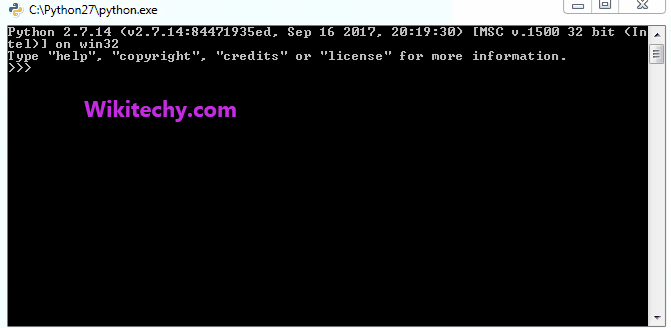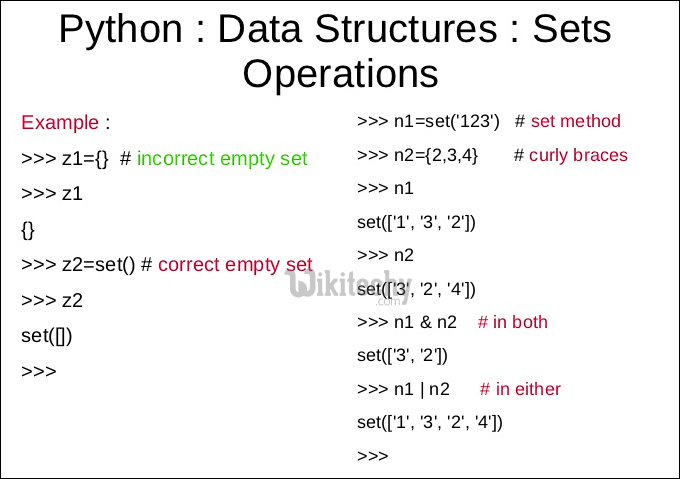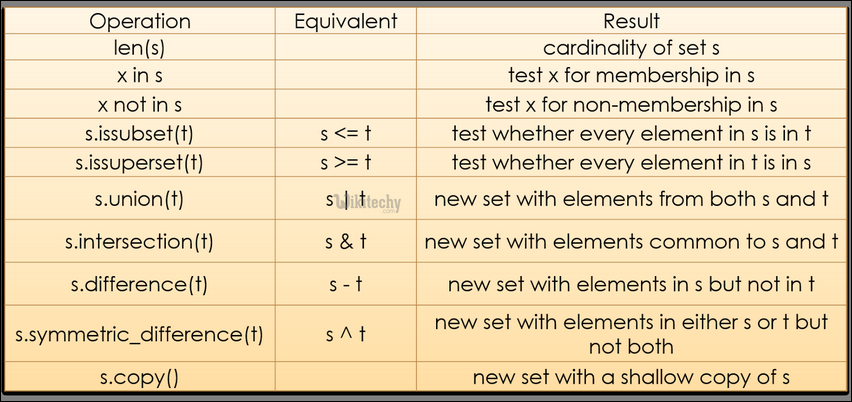
Learn Python - Python tutorial - python sets - Python examples - Python programs
A Set is an unordered collection data type that is iterable, mutable, and has no duplicate elements. Python’s set class represents the mathematical notion of a set. The major advantage of using a set, as opposed to a list, is that it has a highly optimized method for checking whether a speci?c element is contained in the set. This is based on a data structure known as a hash table.

Frozen Sets Frozen sets are immutable objects that only support methods and operators that produce a result without a?ecting the frozen set or sets to which they are applied.
python - Sample - python code :
# Python program to demonstrate differences
# between normal and frozen set
# Same as {"a", "b","c"}
normal_set = set(["a", "b","c"])
# Adding an element to normal set is fine
normal_set.add("d")
print("Normal Set")
print(normal_set)
# A frozen set
frozen_set = frozenset(["e", "f", "g"])
print("Frozen Set")
print(frozen_set)
# Uncommenting below line would cause error as
# we are trying to add element to a frozen set
# frozen_set.add("h")Output:
Normal Set
set(['a', 'c', 'b', 'd'])
Frozen Set
frozenset(['e', 'g', 'f'])

1. add(x) Method: Adds the item x to set if it is not already present in the set.
python - Sample - python code :
people = {"Jay", "Idrish", "Archil"}
people.add("Daxit")-> This will add Daxit in people set.
2. union(s) Method: Returns a union of two set.Using the ‘|’ operator between 2 sets is the same as writing set1.union(set2)
python - Sample - python code :
people = {"Jay", "Idrish", "Archil"}
vampires = {"Karan", "Arjun"}
population = people.union(vampires)OR
population = people|vampires-> Set population set will have components of both people and vampire
3. intersect(s) Method: Returns an intersection of two sets.The ‘&’ operator comes can also be used in this case.
python - Sample - python code :
victims = people.intersection(vampires)-> Set victims will contain the common element of people and vampire
4. difference(s) Method: Returns a set containing all the elements of invoking set but not of the second set. We can use ‘-‘ operator here.
python - Sample - python code :
safe = people.difference(vampires)OR
safe = people – vampires-> Set safe will have all the elements that are in people but not vampire
5. clear() Method: Empties the whole set.
python - Sample - python code :
victims.clear()-> Clears victim set
However there are two major pitfalls in Python sets:
- The set doesn’t maintain elements in any particular order.
- Only instances of immutable types can be added to a Python set.

Sets and frozen sets support the following operators:
key in s # containment check
key not in s # non-containment check
s1 == s2 # s1 is equivalent to s2
s1 != s2 # s1 is not equivalent to s2
s1 <= s2 # s1is subset of s2
s1 < s2 # s1 is proper subset of s2
s1 >= s2 # s1is superset of s2
s1 > s2 # s1 is proper superset of s2
s1 | s2 # the union of s1 and s2
s1 & s2 # the intersection of s1 and s2
s1 – s2 # the set of elements in s1 but not s2
s1 ˆ s2 # the set of elements in precisely one of s1 or s2
Code Snippet to illustrate all Set operations in Python
python - Sample - python code :
# Python program to demonstrate working# of
# Set in Python
# Creating two sets
set1 = set()
set2 = set()
# Adding elements to set1
for i in range(1, 6):
set1.add(i)
# Adding elements to set2
for i in range(3, 8):
set2.add(i)
print("Set1 = ", set1)
print("Set2 = ", set2)
print("\n")
# Union of set1 and set2
set3 = set1 | set2# set1.union(set2)
print("Union of Set1 & Set2: Set3 = ", set3)
# Intersection of set1 and set2
set4 = set1 & set2# set1.intersection(set2)
print("Intersection of Set1 & Set2: Set4 = ", set4)
print("\n")
# Checking relation between set3 and set4
if set3 > set4: # set3.issuperset(set4)
print("Set3 is superset of Set4")
elif set3 < set4: # set3.issubset(set4)
print("Set3 is subset of Set4")
else : # set3 == set4
print("Set3 is same as Set4")
# displaying relation between set4 and set3
if set4 < set3: # set4.issubset(set3)
print("Set4 is subset of Set3")
print("\n")
# difference between set3 and set4
set5 = set3 - set4
print("Elements in Set3 and not in Set4: Set5 = ", set5)
print("\n")
# checkv if set4 and set5 are disjoint sets
if set4.isdisjoint(set5):
print("Set4 and Set5 have nothing in common\n")
# Removing all the values of set5
set5.clear()
print("After applying clear on sets Set5: ")
print("Set5 = ", set5)python tutorial - Output :
('Set1 = ', set([1, 2, 3, 4, 5]))
('Set2 = ', set([3, 4, 5, 6, 7]))
('Union of Set1 & Set2: Set3 = ', set([1, 2, 3, 4, 5, 6, 7]))
('Intersection of Set1 & Set2: Set4 = ', set([3, 4, 5]))
Set3 is superset of Set4
Set4 is subset of Set3
('Elements in Set3 and not in Set4: Set5 = ', set([1, 2, 6, 7]))
Set4 and Set5 have nothing in common
After applying clear on sets Set5:
('Set5 = ', set([]))